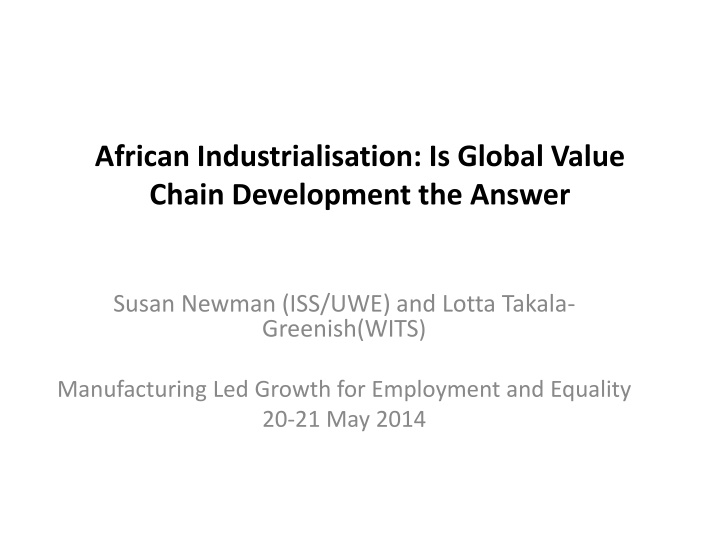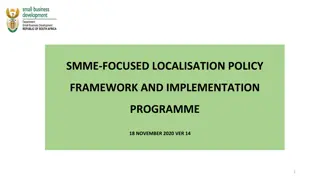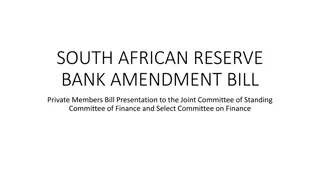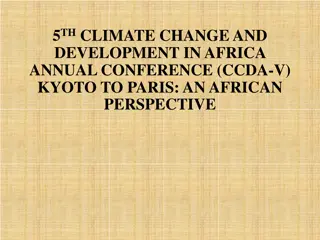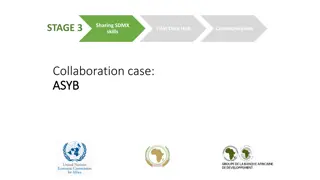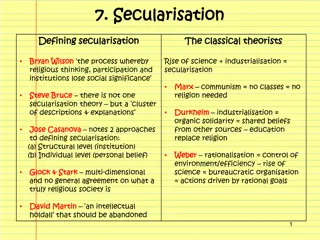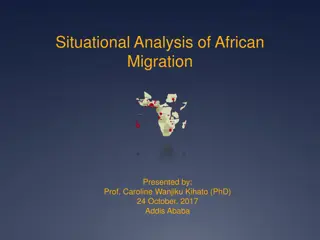African Industrialisation: Key Insights and Implications
This paper delves into different industrial development approaches and assesses the historical context of South African industrialisation in achieving broad-based growth. It explores the significance of manufacturing, cumulative causation, and stages of growth dynamics, drawing on empirical evidence and experiences from South Korea's industrialisation journey.
Download Presentation

Please find below an Image/Link to download the presentation.
The content on the website is provided AS IS for your information and personal use only. It may not be sold, licensed, or shared on other websites without obtaining consent from the author.If you encounter any issues during the download, it is possible that the publisher has removed the file from their server.
You are allowed to download the files provided on this website for personal or commercial use, subject to the condition that they are used lawfully. All files are the property of their respective owners.
The content on the website is provided AS IS for your information and personal use only. It may not be sold, licensed, or shared on other websites without obtaining consent from the author.
E N D
Presentation Transcript
African Industrialisation: Is Global Value Chain Development the Answer Susan Newman (ISS/UWE) and Lotta Takala- Greenish(WITS) Manufacturing Led Growth for Employment and Equality 20-21 May 2014
Aims of the paper Compare the implicit and explicit understanding of industrial development within the Global Value Chain Development (GVCD), Vertically Specialised Industrialisation (VSI) and New Structural Economics (NSE) approaches with those of Kaldor and (Old) Structuralist Economics Provide insights from South African industrial development historically to assess the scope and limitations of resource- based industrialisation in delivering broad-based and equitable growth.
Industrialisation and industrial policy: (old) Structural Economics Developing countries faced the imperative to catch-up through rapid economic growth and development Rapid Industrialisation as key to promoting accelerated economic growth Causal significance of manufacturing in growth Informed by theories of cumulative causation
Cumulative Causation Verdoorn s Law: both productivity and employment grow at a faster rate with higher rates of growth of output owing to increasing returns Sources of (dynamic) increasing returns: Growth pull affects through interdependencies /direct and indirect linkages Economies of agglomeration Learning by doing and using Causal link thus runs from greater complexity of interdependencies across the economy and rapid growth Role of the state in developing and fostering interdependencies
A note on the process of cumulative causation and equality Historically, industrialisation processes have passed through consecutive stages where the growth dynamic is related to different tendencies in the distribution of income across society. Kaldor proposed 4 idealised stages with different types of manufacturing as the key driver of growth - i) domestic wage goods, ii) expansion of exports for consumer goods, iii) heavy industries (capital goods in particular), iv) exports of heavy industry goods: Confirmed empirically by empirical observations of Kuznets (1957), Chenery and Taylor (1968), Kader (1985), Syrquin and Chenery (1989), Haraguchi and Rezonja (2010) Experience of equalising growth in South Korea s industrialisation trajectory
Industrialisation and industrial policy: Orthodox Economics Washington Consensus No causal significance of industrial structure All sectors are alike except for (factor) productivity All state interventions as distorting and impeding the market mechanism Post-Washington Consensus Pervasive market imperfections limit the extent to which markets perform equilibrating role Recognition of the role of the state in supporting the market
Current IP debate Imperative for industrialisation: Heightened competition on global markets Rise of global value chains Mechanisms and Policy industrialisation: Goal of raising competitiveness Insertion into global value chains and upgrading Based on factor endowments Firm centred strategies: partnership between the state and entrepreneurs
Global Value Chain Development Observe a rise in global value chains in the organisation of production globally Opportunities for developing country firms to insert themselves and upgrade Upgrading opportunities come from intra-chain learning and potential for technological diffusion and economies of agglomeration associated with firm clustering Economic thinking behind GVCD is informed by many ideas from old structural economics, such as the economics of agglomeration and dynamic learning processes , but these are couched in a PWC orthodox economics framework Industrial policy amounting to local level support for the private sector
Vertical Specialised Industrialisation Reinterprets history of industrialisation across the world in terms of VSI As in GVC analysis, the cause of the problem of heightened competition offers its own solution: raising competitiveness and developing competitive advantage through chain upgrading. Industrial policy recommendations coming out of VSI thus focuses more on linkages to a set of value chain actors and less on the national economy (Milberg. et. al. 2013, p4). As a result, VSI informed policy recommendations include those that come out of GVC or industrial cluster research and emphasise a policy focus on regulating links to the global economy through trade, foreign direct investment and exchange rate policies.
Resource-based industrialisation GVCD in the context of sub-Saharan economies. UNECA (2013); Morris, Kaplinsky and Kaplan (2012) Bringing together ideas of comparative advantage and industrial upgrading Focus on intersectoral linkages and associated growth pull effects. As in all approaches to industrialisation based on vertical chain approaches, there is no clear mechanism for translating this to broader industrialisation
Industrialisation under Apartheid: An example of Resource based industrialisation Analysis based on the Minerals-Energy-Complex (Fine and Rustomjee 1996) Imperatives for industrialisation came from the political and economic disjuncture between Afrikaner and English capital. Promotion of Afrikaner capital and economic expansion based upon linkages with mining. Promotion by the state of industries linked to mining Result was an industrial structure with a highly cohesive MEC core and weakly linked industries outside of the core This industrial structure has persisted into the post-apartheid period and can in part explain the rapid decline of industries outside of this core, persistent wage inequality and high unemployment.
Deepening of MEC Linkages A set of industries identified by very strong input-output linkages with each other and weak linkages that serve as the core site of capital accumulation Coal mining Gold and Uranium mining Other mining Petroleum, chemicals, rubber and plastic Non-metallic minerals Basic iron and steel Basic non-ferrous metals Metal products excluding machinery Machinery and equipment Electricity, gas and steam Transport and storage
Material interdependencies within (and without) the MEC core in 2010
Share of sectoral net value of output in total manufacturing 1924-2010
Achieving broad-based inclusive growth There are clear gains to be made in terms of contribution to GDP and employment generation from developing forward and backward linkages to extractive industries, in other words, the strengthening of the MEC core. The main concern here is whether this could translate to structural transformation of the type that would result in broader based industrialisation as the driver for inclusive growth.
2.5 Contribution of MEC and non-MEC sectors to employment 2 1.5 Employees (millions) 1 0.5 0 1970 1975 1980 1985 1990 1995 2000 2005 2010 non-MEC manufacturing MEC MEC incl. transport and storage Finance and business services*
Some implications of resource based industrialisation in South Africa The promotion of resource-based development reinforces rather than transforms the prevailing economic structure. It has been shown that promotion, through industrial policy, of large-scale (heavy) industries directly linked to mining resulted in a set of tightly interdependent and integrated industries that has expanded in isolation from, and at the expense of (labour intensive) consumer goods manufacturing. There had been support for labour intensives sectors during the period of industrialisation (as demonstrated by the case of textiles and clothing), this tended to be ad hoc, and took place in the absence of a broader integrated industrial strategy. Although policy did focus upon the development of linked sectors, the aim of industrial policy in the apartheid period was not the development of an integrated, diversified and broad based industrial structure. Our contention is that resource-based industrialisation on its own cannot generate the type of self-sustained and inclusive growth dynamics informed by theories of cumulative causation and the experiences of late industrialising countries such as South Korea.
Conclusions Can GVCD deliver industrialisation? Global Value Chain Development and other forms of vertically- specialised industrialisation such as resource-based industrialisation will not necessarily translate into the broad-based industrialisation. Cumulative causation limited to linked industries No endogenous equalising mechanism making redistribution policy all the more crucial for improving equality We need to be more ambitious in our understanding of industrialisation and industrial policy and the benefits that it can bring.
